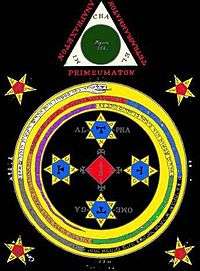Goetia
Goetia or Goëtia (Medieval Latin; anglicised as goety /ˈɡoʊ.ᵻti/) is a practice that includes the invocation of angels or of demons. The use of the term in English largely derives from the 17th-century grimoire The Lesser Key of Solomon, which features an Ars Goetia as its first section. It contains descriptions of the evocation of seventy-two demons, famously edited by Aleister Crowley in 1904 as The Book of the Goetia of Solomon the King.
Goetic Theurgy, another practice described in the Lesser Key of Solomon, is similar to the book's description of Goetia, but is used to invoke aerial spirits.
Etymology
The Ancient Greek word γοητεία (goēteía) means "charm, jugglery, sorcery",[1] from γόης (góēs) "sorcerer, wizard" (plural: γόητες góētes).[2] The meaning of "sorcerer" is attested in a scholion, or commentary, referring to the Dactyli, a mythical race, stating that according to Pherecydes of Syros and Hellanicus of Lesbos, those to the left are goētes, while those to the right are deliverers from sorcery.[3] The word may be ultimately derived from the verb γοάω "groan, bewail" (goáō). Derivative terms are γοήτευμα "a charm" (goḗteuma, plural γοητεύματα goēteúmata) and γοητεύω "to bewitch, beguile" (goēteúō).
Γοητεία was a term for the magic in the Greco-Roman world. Its Latinized form is goëtia; in the 16th century, English adopted it as goecie or goety (and the adjectival form goetic), via French goétie.
Renaissance magic
During the Renaissance, goëtia was sometimes contrasted with magia as black magic (Darkness/Selfish) vs. white magic (Light/Selfless), or with theurgy as "low" vs. "high" magic.
James Sandford, in his 1569 translation of Heinrich Cornelius Agrippa's Of the vanitie and uncertaintie of artes and sciences, writes, "The partes of ceremoniall Magicke be Geocie, and Theurgie." Georg Pictorius in 1562 uses goetie synonymously with "ceremonial magic".
The Ars Goetia
The Ars Goetia is the first section of the Lesser Key of Solomon, containing descriptions of the seventy-two demons that Solomon is said to have evoked and confined in a bronze vessel sealed by magic symbols, and that he obliged to work for him. The Ars Goetia assigns a rank and a title of nobility to each member of the infernal hierarchy, and gives the demons "signs they have to pay allegiance to", or seals. The lists of entities in the Ars Goetia correspond (to high but varying degree, often according to edition) with those in Johann Weyer's Pseudomonarchia Daemonum an appendix appearing in later editions of his De praestigiis daemonum, of 1563.
A revised English edition of the Ars Goetia was published in 1904 by Samuel Liddell MacGregor Mathers and Aleister Crowley as The Goetia which is based on manuscripts from the British Museum, with additions by Crowley, including a Preliminary Invocation drawn from Goodwin's Fragment of a Graeco-Egyptian Work upon Magic, and the essay The Initiated Interpretation of Ceremonial Magic. It is not a faithful edition of the source manuscripts but contains several innovations,[4] including some evocations in Enochian written by Crowley. In his introduction, Crowley argues that the work of demonic evocation is merely a form of psychological self-exploration. It has since become a relatively well-known book of magic and has even been featured in places like the graphic novel Promethea by Alan Moore, James Blish's novel Black Easter, and Kevin Kauffmann's Forsaken Comedy trilogy.
The Sacred Magic of Abramelin the Mage
The Sacred Magic of Abramelin the Mage[5] is considered both a theurgic and goetic book of magic, mostly used in a religious context. Contrary to the other Goetia Grimoires, this book does not denote the evocation of demons to do one's bidding or involuntary handiwork, but describes how one might summon these infernal forces, solely for the purpose of excommunicating them from the life of the Magus.[6] This book was considered a system that led the aspirant closer to the goal of henosis, or spiritual reunion with God. Describing how to summon the dukes of Hell, even Lucifer, for the purpose of resisting the temptation of their vices, and binding their influence in the aspirant's life.
This book describes a system of holy magic through an eighteen-month purification, then after the conversation of the Holy Guardian Angel, one would summon the four Great Kings of Hell (Lucifer, Leviathan, Satan, Belial), and make them sign an oath. This Oath (after gaining the power of the supernal realm), would grant the Adept power over the Infernal Realm and aid the Adept in discovering the "True and Sacred Wisdom" in the form of magic squares.
In popular culture
See also
Notes
- ↑ "LSJ". Perseus.tufts.edu. Retrieved 2013-10-18.
- ↑ "LSJ". Perseus.tufts.edu. Retrieved 2013-10-18.
- ↑ Muller, Carl Otfried; Müller, Theodor; Carl, Müller (2010). Fragmenta Historicorum Graecorum. Cambridge University Press. ISBN 9781108016605.
Ἀριστεροὶ μὲν, ὥς φησι Φερεκύδης, οἱ γόητες αὐτῶν· οἱ δὲ ἀναλύοντες, δεξιοὶ, ὡς Ἑλλάνικος.
- ↑ Stephen Skinner & David Rankine, The Goetia of Dr. Rudd Golden Hoard Press, 2007, pp. 47–50
- ↑ The Secrets of the Magical Grimoires, By: Aaron Leitch Chapter 1
- ↑ "Sacred Magic of Abramelin: The Second Book: The Seventeenth Chapter. What We Should Answer Unto the Interrogations of the Spirits, and How We Should Resist Their Demands". Sacred-texts.com. Retrieved 2013-10-18.
References
- E. J. Langford Garstin, Theurgy or The Hermetic Practice: A Treatise on Spiritual Alchemy. Berwick: Ibis Press, 2004. (Published posthumously)
- Aleister Crowley (ed.), Samuel Liddell Mathers (trans.), The Goetia: The Lesser Key of Solomon the King. York Beach, ME : Samuel Weiser (1995) ISBN 0-87728-847-X.
- Stephen Skinner, & David Rankine, The Goetia of Dr Rudd: The Angels and Demons of Liber Malorum Spirituum Seu Goetia (Sourceworks of Ceremonial Magic). Golden Hoard Press, 2007. ISBN 978-0-9547639-2-3
